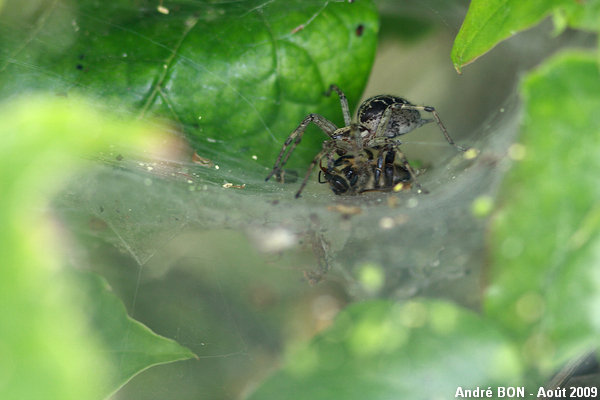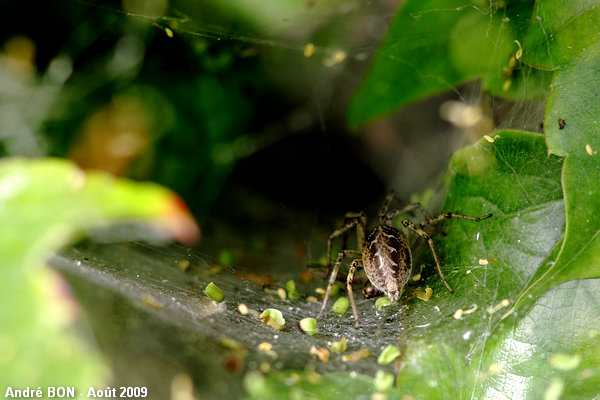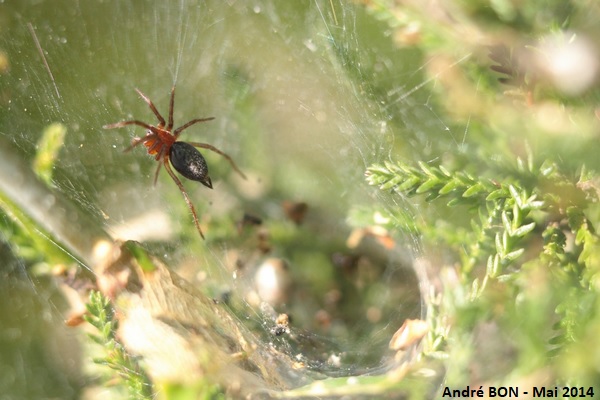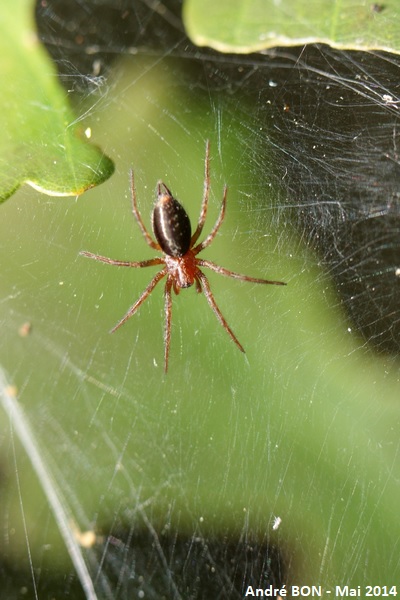





| Labyrinth Spider (Agelena labyrinthica (Clerck, 1758)) |






|
|
Scientific name: Agelena labyrinthica (Clerck, 1758) Common name: Labyrinth Spider French name: Agélène à labyrinthe Order: Araneae Family: Agelenidae Size: 15 to 18 mm. Biotope: Dry habitats with low growing vegetation. Web: The web includes a large non-sticky horizontal sheet below a jumble of threads. It extends with a funnel-shaped retreat where the spider hides and takes shelter. These webs are never located higher than 1.5 meter and are usually below 60cm high. There are often built along grassy banks or small bushes and often facing south. Observation period: You can observes adults in July and August. Geographic area: Palaearctic region. |
The abdomen of the Labyrinth Spider shows a central pale brown stripe between two darker greyish bands. These bands show short white oblique lines then drawing some kind of a fishbone. The Labyrinth Spider has large spinnerets at the rear of the abdomen. As soon as an insect makes the threads vibrate, the Labyrinth Spider runs out of its tunnel to try to catch it. The funnel-shaped retreat is also used to protect the egg sac and the developing young spiders. There is a similar species, Allagelena gracilens which is difficult to tell apart. However it is a smaller size, from 7 to 11 mm. It spins very smaller webs (15 to 20 cm) and often located at a height of more than 80cm in the vegetation. You can also distinguish two small white streaks that start from the base of the abdomen and frame more diffuse patterns. |
| [To know more about the Labyrinth Spider] [Next picture] [Top] |

|
The Labyrinth Spider here stands at the entrance of its retreat tunnel. You can clearly see the funnel-shaped web. |
| [To know more about the Labyrinth Spider] [Next picture] [Previous picture] [Top] |

|
This Labyrinth Spider has spun its web next to the lavender plant in my garden. This is a very well chosen place as many insects come over here to gather nectar and some of them are not very lucky. This is also a well chosen place for me so that I can do nice observations. |
| [To know more about the Labyrinth Spider] [Next picture] [Previous picture] [Top] |

|
In wildlife photography it is required to focus so that the eye is very sharp on the picture. However a backside view may show some interest for naturalists. You can clearly see, on this picture, the fishbone pattern and the large spinnerets at the rear of the abdomen. |
| [To know more about the Labyrinth Spider] [Next picture] [Previous picture] [Top] |

|
After the backside view, here is the front view, with a prey. The large size of this spider enables me to think that this is Agelena labyrinthica. Allagelena gracilens is normally a smaller size. |
| [To know more about the Labyrinth Spider] [Next picture] [Previous picture] [Top] |

|
I have somehow hesitated about the species identification of this spider observed in the forest because of its moderate size and because of the location of the web being about at one metre from the ground. However, the large size of the web and the dark streaks starting from the base of the abdomen make me decide for the Labyrinth Spider species. |
| [To know more about the Labyrinth Spider] [Previous picture] [Top] |

|
Another view of the same specimen. The well marked patterns on the abdomen also lead to the Agelena labyrinthica species. |